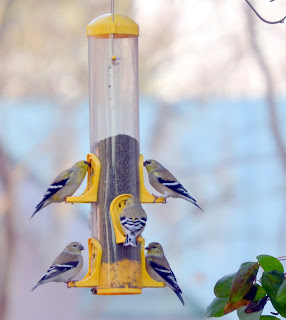A friend of mine had a flock of
small birds at her feeders that she could not identify. She had looked in books
but the dull yellowish grey birds were a mystery. I asked her could they be
Pine Warblers or Yellow-rumped Warblers and she said “No they did not look like any of those birds.” It dawned on me that she had a flock of
Goldfinches at her feeders but the small bird field guide she had only showed
birds in their summer plumage. Many
birds have such different seasonal plumages that they look like completely
different birds. It is important to
purchase a bird field guide or smart phone app that has all a bird’s plumages.
Some smart phone apps also come with bird songs and calls and this feature can
help correctly identify some birds. The
flight call of the American Goldfinch sounds like they are chirping “potato
chip, potato chip, potato chip”. While most birds fly in beautifully synchronized
flocks, a goldfinch flock looks like chaos.
A goldfinches flight pattern looks they are on a roller coaster, as one
bird swoops up another swoops down. I
have often wondered why they don’t collide.
Like other finches, the goldfinch
has a short conical bill that is ideal for opening and consuming seeds. At the feeder, they can quickly clean you
out. They prefer oil sunflower and nyjer
seeds at the feeders and will eat on the feeders or on the ground. In the wild, they seek out seeds of any
member of the aster family with thistle and dandelion being some of their favorites.
They also eat grass and other weed seeds. Unlike other song birds which consume
some insects, the goldfinch has a pure vegetarian diet.
Goldfinches live in central Virginia year round. They change their plumage twice a year. In late summer, they
transform from sunny yellow to dull little birds. In the late winter,
they shed their dull winter feathers for bold summer colors.
Goldfinches are our smallest finch;
they are about the size of a chickadee. They are often seen feeding with House
finches in the winter. Keep your
feeders full this winter and when spring comes, maybe you will be able to see
them change into their colorful summer feathers.


